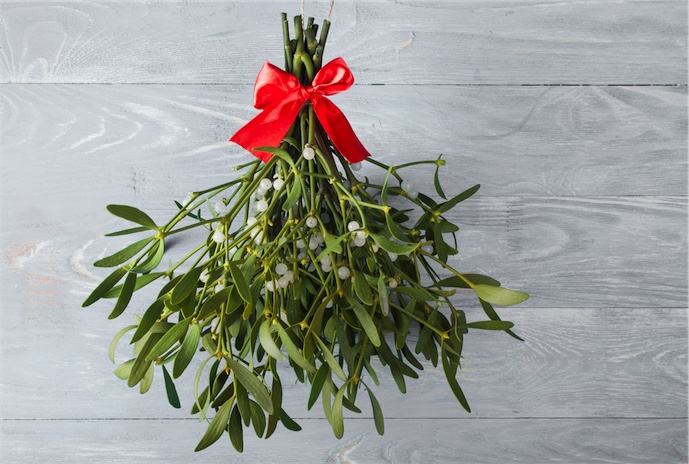Mistletoe (Viscum album) brings to mind Christmas canoodling but it has a history that reaches back to the Celtic Druids.
What’s in a name?
The origins of the word mistletoe are somewhat less romantic. Some etymologists believe it originates from the old German words “mist” for dung and “tang” for branch. This is plausible. This semi-parasitic plant is passed from tree to tree by birds who eat the berries.
**Please note: leave the berry eating to the birds as they are poisonous to humans.
A parasitic plant
The seeds attach to the host tree and mistletoe feeds from the tree’s table although, to be fair it does also produce its own nourishment. In European climes the mistletoe remains evergreen. This may have given rise to the myths and folklore surrounding it. When everything else was dormant and seemingly lifeless mistletoe was a green beacon.
The mighty mistletoe of legend
According to folklore there was pretty much nothing mistletoe was not good for. Want to find hidden treasures? Mistletoe’s your parasite. How about avoiding military service and protection from fire? Yep – got that covered too. It was also believed to keep witches away, improve the fertility of your horse, your land and prevent nightmares.
What about the kissing thing?
There’s differing accounts of how mistletoe and smooching became inextricably linked. One arises from a Norse legend. The hero, Balder, was badly wounded by an arrow made of mistletoe. His mother, Frigg, wept over the arrow and the tears turned to berries which she used to heal the wounds. Frigg then blessed the plant and promised kisses to all who passed beneath it.
It may also arise from an ancient custom of kissing the hand of the host as you entered their home at Yule celebrations. Mistletoes as an evergreen was popular for decorations. This evolved over time into something a little more personal!
Medicinal mistletoe
Hypertension
Mistletoe is by herbalist today for managing hypertension, especially high blood pressure associated with atherosclerosis. It is thought mistletoe can improve circulation to those areas where blood supply is reduced due to muscular tension.
Nerve tonic
It is also used as a nervous system tonic. Indicated with an “irritable” nervous system and may be able to support the reduction of cerebral excitement seen in epilepsy.
Support for cancer
Recent research has focused on possible uses in cancer to support the body’s immune system, and reduce fatigue and other side effects associated with conventional treatment. It is not considered a stand-alone treatment but rather a support for other therapies.
Mistletoe may also be useful in managing hot flushes and amenorrhoea.
Not just a herb for kissing
Mistletoe is a powerful herb and should only be used under the guidance of a suitably qualified person. It may interact with pharmaceutical medications and is not suitable during pregnancy and breastfeeding.
If you liked this, you might also enjoy:
10 natural essentials to survive the silly season

Need help with your skin?
Norelle Hentschel is an experienced Naturopath with a clinic in Stones Corner, South East Brisbane and also offers Telehealth consults Australia wide. She enjoys supporting her clients to reach their health goals.
Want more articles like this?
Receive a monthly digest of natural health information to help you become “health” sufficient!
PS. Your inbox real estate is precious, and we will never annoy you with sales pitches or share your details with anyone else. One email a month — that’s it.

